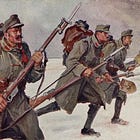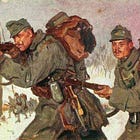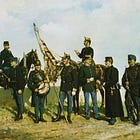This article is the third in a series that, taken together, contains the full text of a study written in 1947 by Lothar Rendulic. The first two articles in the series can be found below.
The senior commander will frequently have an opportunity to confer with his subordinates on the situation and to express his views prior to issuing his order. He should follow this practice whenever possible. In these conferences the senior commander will present his estimate of the situation and furnish an outline of his decision, which may still be in the making. At the same time, he will acquaint himself with additional salient details (such as his own and the enemy situation, and the importance of certain terrain features, etc.), which pertain to the sectors of his subordinate commanders, and he will listen to their personal opinions. To be sure, the senior commander must particularly on these occasions, guard against undue influence which some of his subordinates may bring to bear upon his decision. The order of the senior commander may occasionally deviate from the outline that was orally discussed because of a new development in the situation or of orders from above. It will then be necessary to point out the reason for this deviation to the junior commanders; yet, in this event it will be appropriate to separate the justification from the order.
Such conferences may frequently be conducted even after the order has been issued. They will mostly take place on occasions when the senior commander visits the subordinate's command post prior to or during a combat action. During such visits, he must discourage any attempts to make him change his order unless new developments in the situation demand it. On the contrary, he must avail himself of the opportunity to lend emphasis to the order by putting in a personal appearance, whenever it is called for. The senior commander will also interfere with the subordinate's conduct of operations, if he gains the impression that the junior commander has not understood the order correctly or is not displaying sufficient initiative. This kind of interference is called for under the circumstances; it has nothing to do with meddling and may be of decisive importance to the success of the operation.
At times, the course of events may be such that the visiting senior commander will be called upon to elaborate upon the given situation and to personally issue important new orders right on the spot. Such verbal orders are frequently preceded by a talk with the respective subordinate about events, the situation, etc. This discussion is natu- rally conducted in a conversational tone. Subsequent verbal orders, however, should not be given in this tone, but in such a manner that they are clearly recognized as orders.
Having issued verbal orders, the senior commander who fails to inform his headquarters personnel of this fact will make their work considerably more difficult, so that confusion will frequently ensue. At the very least, he will jeopardize the continuity and precision of the work. An additional reason for keeping the personnel at head- quarters informed is that important verbal orders have to be confirmed later on by letter or teletype. This confirmation is part of the duties of the headquarters personnel.
The opportunity to give verbal orders presented itself to me most often in my capacity as commanding general of armies and army groups. I issued such orders either during my presence at the command posts of the respective junior commanders or in the course of telephone conversations, which had been initiated either by myself or by the respective subordinate. As a matter of course, my headquarters personnel subsequently put these verbal or telephone orders into writing, and, as a rule, dispatched them by teletype to the commands which had received them orally. Orders of minor importance should at least be entered in the journal. An aide, who was part of my entourage, had standing orders to keep my headquarters personnel informed of all verbal orders issued outside the headquarters.
Written orders must be executed in such a fashion that they can be easily understood. For this reason, they must be clearly arranged and should not be too lengthy. Every superfluous word should be avoided. Brevity, however, must not be attained at the expense of clarity. Experience with combat orders has shown that the sequence and organization of material as prescribed in our service regulations is conducive to a quick comprehension of such orders and to a thorough familiarization with their con- tents.1
The most important paragraphs of an order are as follows:
1. Own and enemy situation.
2. Own intentions.
3. Mission
4. Activity of adjoining units (if not already indicated under 3.)
5. Possible co-operation with other arms.
6. Own command post.
Such a logical, standard arrangement also facilitates the finding of the salient points in combat orders. All information of lesser importance should either be included in annexes or published in separate orders, because otherwise combat orders will be- come too lengthy, complex, and ponderous.
Point 1 (enemy situation) is a case in point. A special section in each headquarters compiled data on the enemy situation. These sections put out reports which, of course, were often very voluminous. Such reports were disseminated either separately or as annexes to orders. Just the same, orders must also contain, in brief, the essential elements of enemy information which the senior commander considers important.
Special annexes may be attached to field orders, as for example the artillery annex in the case of large scale attacks, the engineer annex in the case of forced river crossings, aviation and tank annexes whenever these arms co-operate with the infantry, and a good many other types of annexes. Field orders must make references to these special annexes; they must, moreover, briefly state instructions of great importance which are contained in these annexes. From division up, orders for supply operations are always issued in a special annex -- a procedure that renders superfluous any reference to supplies in the body of field orders.
Finally, the commander must draw up combat orders with an eye towards safeguard- ing information. Any order may fall into enemy hands; consequently it must not contain much information that may be useful to the enemy. For this reason, orders should only contain such information about our situation and about our intentions as may be required by the junior commander in order to execute his mission and, in the case of unforeseen developments, to act in continuity with the intentions of the senior commander.
Let us now elaborate briefly on changes in orders. In wartime, units were frequently required to perform missions which by far exceeded the limits of what they could be expected to accomplish on the basis of peacetime training. Many a unit commander found it difficult to adapt himself to this novel situation, and consequently harbored a feeling of insecurity. This feeling, coupled with the fact that many commanders could not always completely familiarize themselves with the overall situation and confined their attention to their own sector, resulted in opposition to orders aimed a bringing about a change. The senior commander must remain firm in the face of such opposition.
On the other hand, it is not always wise to adhere rigidly to orders once they have been issued; this holds particularly true if there is a change in the situation and in its evaluation, on which the commander has based his decision and also his orders. In numerous instances such changes can happen very quickly. In this connection, however, I should like to refer to a specific statement in the study The Command Decision, namely, that a change in the situation, especially if it results from enemy action, does not necessarily require in every instance a change in the decision and thus also in the orders.2 Such changes are certainly not called for, if the commander does not want to lose the initiative. In such instances, however, where the execution of his own plans can be effected, it will have to be made without hesitation. In the event of a rapidly developing tactical situation due consideration must be given to the fact that orders, if not completely so, are at least partially obsolete by the time they reach the subordinate.
The four components of this article can be found below:
For more about the Foreign Military Studies program:
To support, share, or subscribe:
Readers familiar with the US Armed Forces will recognize the similarity between this framework and that of the “five paragraph order.” For more on the latter, and its connection to German practice at various points in time, see The Paradox of the Five Paragraph Order.
The Command Decision is another one of the twenty-two studies that Dr. Rendulic wrote for the Foreign Military Studies program. Soon after my next visit one of the few repositories that holds a copy of this document, I will publish it in The Tactical Notebook.









